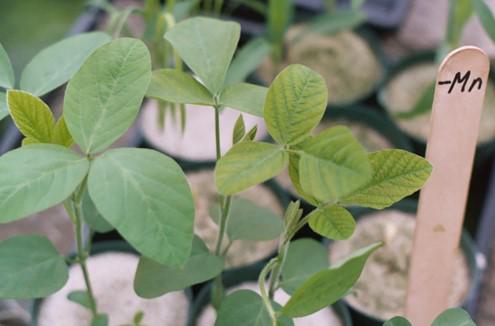Introduction
Three tools are used to evaluate crop nutrient availability: (1) soil analysis, (2) plant analysis, and (3) visual diagnosis of nutrient deficiencies. Soil analysis is used to predict the fertilizer requirement for a certain crop, while plant analysis is used to check the plant’s nutritional status. With an understanding of specific plant nutrient deficiency symptomology, the producer may make important visual diagnoses and gain insight on whether plant nutrition is actually involved. When the three evaluation tools are integrated, it is hoped that soil analysis and the application of appropriate lime and fertilizer rates will reduce nutrient limitations, while plant analysis based on either a routine sampling schedule or a visual problem diagnosis is used to document specific additional nutrient limitations.
Nutrient deficiency occurs when 1 of the 17 essential plant nutrients is not available in sufficient quantity to meet the requirements of a growing plant. Producers, Extension agents, and crop consultants should be able to recognize the main symptoms of nutrient deficiencies. It is important to interpret the scenario correctly to determine if timely intervention can minimize current crop yield loss, or whether it is more effective to wait and resolve the nutritional problem for future crops.
Each nutrient plays a different role in the plant. Lack of a particular nutrient will first impair specific physiological processes that lead to an identifiable visual abnormality. In addition, some nutrients are mobile in the plant, while others have low mobility. When the uptake of a mobile nutrient decreases, it can be translocated from the older to the younger parts of the plant. As a consequence, deficiency symptoms appear first in older leaves for mobile nutrients such as nitrogen (N), phosphorus (P), potassium (K), magnesium (Mg), molybdenum (Mo), and chlorine (Cl). For immobile nutrients, symptoms appear first in the young leaves or rapidly forming reproductive tissues (flowers, fruits, and seeds). These immobile nutrients include calcium (Ca), sulfur (S), iron (Fe), manganese (Mn), copper (Cu), zinc (Zn), and boron (B).
Although the visual symptoms indicate that something is wrong with the crop, it may be difficult to correctly identify a specific nutritional cause. Diagnosing via visual symptoms includes the following limitations:
- Deficiency symptoms of different nutrients can appear similar.
- More than one nutrient can be deficient at the same time, making the identification difficult.
- Different species (or varieties) can express symptoms differently.
- Other factors can produce symptoms similar to some plant deficiencies, such as diseases, droughts, insects, herbicide side-effects, and excessive rainfall.
- Crops can present “hidden hunger,” in which the nutrient is below the optimum level but there are no visual symptoms.
- Deficiency symptoms evolve with time, and the symptoms may appear different than “expected” symptoms.
- Deficiency of a certain nutrient can negatively affect the uptake of other nutrients. Therefore, the visual symptoms can be misleading, pointing to the wrong factor.
Due to these limitations, when plants with visual symptoms of nutrient deficiency are found in a field, it is very important to perform soil and tissue testing to correctly identify the problem. Nematode assay may be important too. In this factsheet, we present the main symptoms of Mn deficiency in soybeans and the recommended management for North Carolina soils.
Management recommendations are based on experiments conducted at research stations and commercial farms in North Carolina and other regions. Producers wishing to conduct their own on-farm trials can use resources available through Cooperative Extension agents and the North Carolina Department of Agriculture & Consumer Services (NCDA&CS) Regional Agronomists. They can also rely on precision technology to apply products and monitor crop yields. Such studies are most likely to provide useful information when they follow a few simple guidelines:
- Fertilizer treatments should be compared to a “control,” usually an untreated area.
- Treatments and controls should be replicated, which avoids the problem of basing conclusions on a single field area that may not be representative.
- Control and fertilizer treatments should be randomly assigned to field areas.
- Allow adequate time for rain to wash any foliar fertilizer off the leaf surfaces before taking any plant tissue samples. Otherwise, laboratory results may suggest greater nutrient uptake, even though the nutrients may not have moved into the plant.
Occurrence
Manganese deficiency is the most common micronutrient deficiency in North Carolina. Its deficiency is most common in coarse-textured, low organic matter coastal plain soils where levels are inherently low. A pH-induced deficiency is more likely to occur in these soils when overlimed. Soils where poultry litter has been applied repeatedly over the years also can present high pH and induced Mn deficiency.
Symptoms
Manganese deficiency presents as interveinal chlorosis, and the whole plant can appear pale green (Figure 1A and Figure 1B).
Management
A major key to prevention is to avoid overapplication of lime. The visual deficiency diagnosis needs to be confirmed by diagnostic soil and plant analysis, but many experienced agronomists readily recognize symptoms. Procedures for diagnostic sampling can be found at NC State Extension’s soil fertility webpage. When Mn deficiency is detected in a soybean field during the growing season, it is best treated with a foliar feed as soon as seen. Soil-applied fertilizer can also be broadcast on the field if the cause for the Mn deficiency is not the occurrence of excessively high soil pH. If needed, consult your Cooperative Extension agent, NCDA&CS Regional Agronomist, crop consultant, or certified crop advisor (CCA) for help in rate and fertilizer selection.
Publication date: Dec. 4, 2020
Reviewed/Revised: Oct. 16, 2025
AG-897-07
N.C. Cooperative Extension prohibits discrimination and harassment regardless of age, color, disability, family and marital status, gender identity, national origin, political beliefs, race, religion, sex (including pregnancy), sexual orientation and veteran status.
N.C. Cooperative Extension prohibits discrimination and harassment regardless of age, color, disability, family and marital status, gender identity, national origin, political beliefs, race, religion, sex (including pregnancy), sexual orientation and veteran status.


